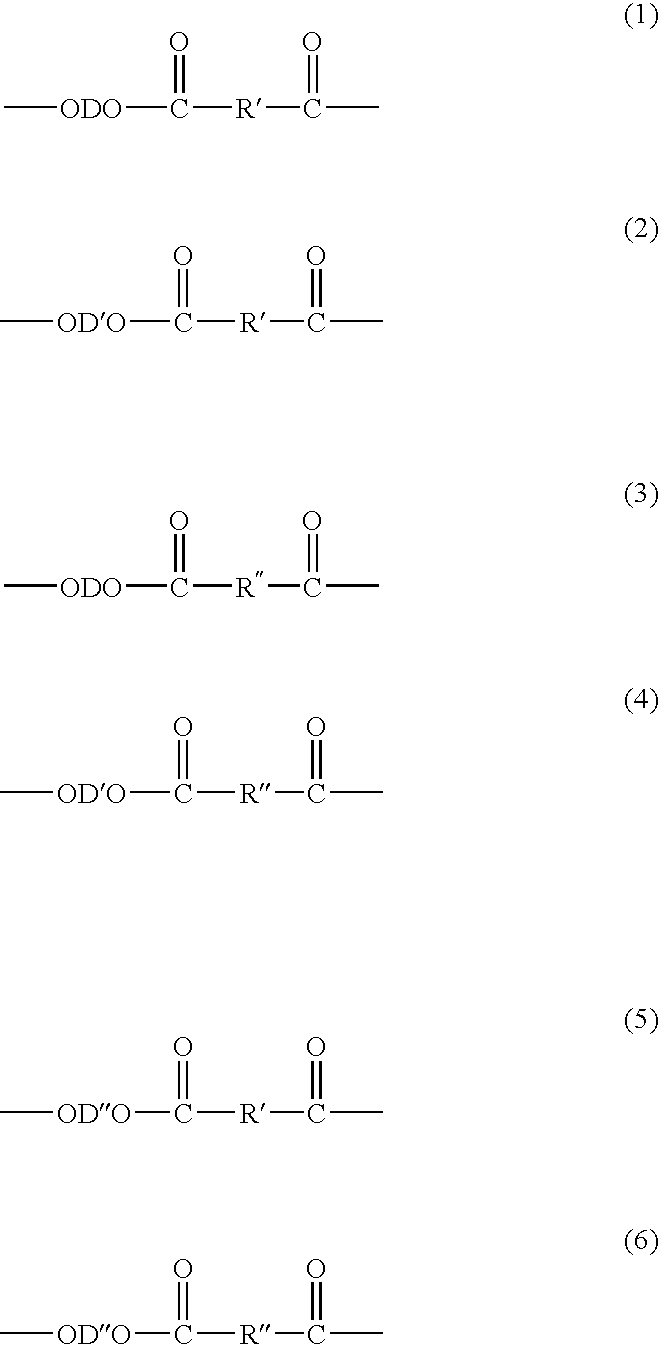Poly(butylene terephthalate) compositions, methods of manufacture, and articles thereof
a technology of polybutylene terephthalate and composition, which is applied in the field of polybutylene terephthalate composition, methods of manufacture, and articles, can solve the problems that conventional pbt molding compositions cannot be made from recycled sources of pbt, and the difficulty of obtaining modified pbt compositions possessing desirable mechanical, thermal, optical properties
- Summary
- Abstract
- Description
- Claims
- Application Information
AI Technical Summary
Benefits of technology
Problems solved by technology
Method used
Image
Examples
examples
[0137]Table 1 lists the components used in the examples.
TABLE 1AbbreviationDescriptionSupplierPETRecycle poly(1,4-ethylene terephthalate)SABICpelletsInnovativePlasticsPBT-1Poly(1,4-butylene terephthalate), intrinsicSABICviscosity of 0.66 dl / g as measured in aInnovative60:40 wt. % phenol / tetrachloroethanePlasticsmixture at 25° C.PBT-2Poly(1,4-butylene terephthalate), intrinsicSABICviscosity of 1.0 dl / g as measured in aInnovative60:40 wt. % phenol / tetrachloroethanePlasticsmixture at 25° C.PBT-3Poly(1,4-butylene terephthalate), intrinsicSABICviscosity of 1.2 dl / g as measured in aInnovative60:40 wt. % phenol / tetrachloroethanePlasticsmixture at 25° C.PVCPolyvinyl chlorideN / ATPTTitanium tetraisopropoxideDupontBDO1,4-ButanediolBASFNylon 6—N / ANylon 6,6—N / APLAPolylactic acidN / ALDPELow density polyethyleneN / APhosphite2,4-Di-tert-butylphenol phosphite, sold asCiba-GeigyIRGAPHOS 168Epoxy-BrTetrabromo bisphenol A diglycidyl etherDowwith epoxy end groupsAO60Antioxidant 60N / AGlassChopped glass fib...
examples 1-8
Modified PBT Copolymer Molding Compositions Containing PVC
[0147]Examples 1 to 8 illustrate the properties of the modified PBT copolymer compositions as follows:[0148]Example 1: Modified PBT made from PET containing 115 ppm PVC.[0149]Example 2: Modified PBT made from PET containing 287 ppm PVC.[0150]Example 3: Modified PBT made from PET containing 575 ppm PVC.[0151]Example 4: Modified PBT made from PET containing 1150 ppm PVC.[0152]Example 5: Glass filled composition made from modified PBT synthesized from PET containing 115 ppm PVC.[0153]Example 6: Glass filled composition made from modified PBT synthesized from PET containing 287 ppm PVC.[0154]Example 7: Glass filled composition made from modified PBT synthesized from PET containing 575 ppm PVC.[0155]Example 8: Glass filled composition made from modified PBT synthesized from PET containing 1150 ppm PVC.
Examples 1 and 3 were prepared in a helicone reactor with the capacity of 65 gallons about 200 liters). Examples 2 and 4 were prepa...
examples 1 and 3
200 Liter Pilot Plant Process (BDO:PET=3:1)
[0157]The helicone reactor had a capacity of 200 liters and was equipped with a special design of twin opposing helical blades with 270 degree twist; constructed of 316 stainless steel with 16 g polish finish. The blade speed could be varied from 1 to 65 rpm. The agitators were connected to a Constant Torque Inverter Duty Motor, which operates at 230 / 460 VAC, 3 PH, and 60 Hz. These agitators provided excellent surface area for the polymer melt in order to build molecular weight. The helicone was also designed with an overhead condenser to condense the vapors in the glycolysis, transesterification (if any), and polymerization stages.
[0158]100 lbs (45.4 kg) of recycle PET pellets with 140 lbs (63.6 kg) of butanediol (BDO) (molar ratio 2.9: 1) were charged to the helicone reactor. 18.8 ml (60 ppm as Ti) of titanium tetraisopropoxide (TPT) catalyst was also added to the reaction mix. PVC pellets were weighed (5.2 and 26 g respectively for examp...
PUM
| Property | Measurement | Unit |
|---|---|---|
| melting temperature | aaaaa | aaaaa |
| surface area | aaaaa | aaaaa |
| heat deflection temperature | aaaaa | aaaaa |
Abstract
Description
Claims
Application Information
 Login to View More
Login to View More - R&D
- Intellectual Property
- Life Sciences
- Materials
- Tech Scout
- Unparalleled Data Quality
- Higher Quality Content
- 60% Fewer Hallucinations
Browse by: Latest US Patents, China's latest patents, Technical Efficacy Thesaurus, Application Domain, Technology Topic, Popular Technical Reports.
© 2025 PatSnap. All rights reserved.Legal|Privacy policy|Modern Slavery Act Transparency Statement|Sitemap|About US| Contact US: help@patsnap.com



